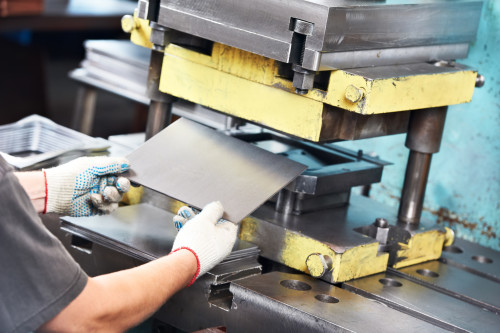What is Metal Stamping?

Metal stamping refers to a manufacturing process whereby flat metal sheets are converted into distinct shapes. It is usually a complicated process and can involve various metallurgy techniques. These are the likes of punching, blanking, piercing and bending, just to mention a few. Across the United States, there are thousands of stamping companies. They specialize in the delivery of components for the automotive industry, medical industry, aerospace as well as many other industries that heavily utilize metals.
As demand increases and global markets evolve, there is a greater need for fast production of numerous complex parts. stamping is a very quick and cheap solution for such a large-scale manufacturing requirement. Most manufacturers who require stamping for their projects typically look out for three fundamental qualities:
- Durability/quality
- Low cost
- Fast production and delivery
Below are some of the formulas and best practices commonly applied in the design process of this activity, including tips on how to incorporate cost-saving measures.
The Basics
Stamping entails the placement of flat metal sheets into a stamping press. Thereafter, a die surface and a tool transforms the metal into the requisite shape. Prior to this process, the stamping technicians must create a design of the tool through CAM/CAD software. The design needs to be of extremely high precision to ensure that every bend and punch maintains the right clearance as well as optimum quality. A 3D model of a single tool can contain multiple hundreds of parts. Therefore, this process is usually meticulous and time-consuming. After completing the designing process, manufacturers can then use various types of grinding, machining, wire EDM as well as other manufacturing services to wind up the production
Types of stamping procedures
There are three common types of metal stamping procedures: fourslide, progressive & deep draw.
Progressive die stamping
This type of stamping involves multiple stations, each of which has a specific function. Initially, strip metal is inserted via a progressive stamping press. Thereafter, the strip steadily unrolls from a coil then into a die process. Each station within the tool makes a different punch, bend or cut. The work of each successive station contribute onto the work performed by the previous stations. This results in a complete part.
Manufacturers might be forced to continuously change the tolls on a given single press or utilize multiple presses with each undertaking a specific task required for the completion of the part. Despite the use of multiple presses, manufacturers often required secondary machining services to ideally process a part to its completion. For this reason, progressive die stamping forms an ideal solution while creating metal parts with complicated shapes. This aims to meet:
- Low labor costs
- Fast turnaround
- Shortening of run lengths
- Higher repeat rate
Fourslide stamping
Fourslide stamping comprises a horizontal alignment accompanied by four separate slides that simultaneously shape the metal piece. This allows for complex bends and high-precision cuts enabling the creation of highly complicated parts. The major advantages of fourslide stamping over traditional press stamping is that it is highly versatile for complex parts, and it allows for more flexibility when making design changes.
Deep straw stamping
This stamping method uses a punch to pull a sheet metal blank into the die that subsequently forms it into shape. In case the depth of the drawn part is larger than its diameter, the process is known as deep drawing. The method is ideal for the creation of components that require a series of diameters. These include aircraft parts, automotive components, cookware, and electronic relays among others.








